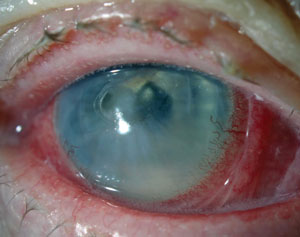 |
Q: Do you have recommendations for antibiotic prophylaxis when using a bandage contact lens (BCL)? I’ve never had an infection while using a BCL in more than 30 years of practice until I switched to generic Polytrim (trimethoprim/polymyxin B). However, I’ve had two infections while using a BCL in the past year. Is there concern regarding use of the generic? Should I be using a different topical treatment?
A: “Bandage contact lenses are used for a variety of reasons, not all involving an epithelial defect,” says Aaron Bronner, OD, of the Pacific Cataract and Laser Institute. “However, in cases dealing with an epithelial defect, compounding risk with BSL necessitates the use of topical antibiotic prophylaxis.” When using prophylaxis along with a BCL, Dr. Bronner notes, it’s important to keep the antibiotic at therapeutic dosage levels to prevent drug-resistant infectious ulcers. “Dosing an antibiotic BID when it’s meant to be dosed at QID does nothing but select out for the highly succepible colonies, thereby directly selecting for growth of more resistant colonies.”
 | |
| A perforated and highly resistant infectious corneal ulcer, which developed in an eye with neurotrophic disease and chronic BCL and antibiotic therapy. Photo: Aaron Bronner, OD. |
Polytrim has good coverage against certain pathogens, including MRSA, Haemophilus influenzae and even Pseudomonas aeruginosa, says Paul Karpecki, OD, of Koffler Vision Group in Kentucky; however, the decades-old approval of its formulation has led to bacterial resistance over time. For example, methicillin-resistant coagulase negative Staph. (MRCoNS) is no longer susceptible to trimethoprim. Manufacturers of generics must also show bioequivalence to branded medication, but can alter preservatives, additives and pH levels, further impacting the drug’s effectiveness. Dr. Karpecki uses the drug to treat children who have not been previously exposed to it, but combines it with the fluoroquinolone Besivance (besifloxacin 0.6%, Bausch + Lomb) when treating MRSA conjunctivitis in adults.
So what similar topical treatments exist? Broad-spectrum antibiotics are the best choice, Dr. Karpecki says. He suggests besifloxacin for treating MRSA, MRSE, P. aeruginosa and even fluoroquinolone-resistant Staphylococcus strains. The high cost of besifloxacin may be a limiting factor for patients without a drug plan, however. “Other fluoroquinolones such as moxifloxacin, gatifloxacin or ofloxacin don’t have quite the broad coverage of besifloxacin,” Dr. Karpecki says, “but still have very broad coverage and other attributes—like moxifloxacin being preservative-free.” Generic tobramycin or gentamycin are also good possibilities; however, long-term use can result in corneal toxicity.
Dr. Bronner adjusts his selection depending on risk level. “In lower risk eyes,” he says, “I often use generic ofloxacin 0.3% QID, [though] in eyes where the induced trauma is more likely to carry infectious material or where pre-existing ocular surface disease increases risk, I’ll use a newer generation agent, typically Vigamox (moxifloxacin, Alcon) rather than Moxeza (moxifloxacin hydrochloride, Alcon). I like the lack of preservative for these eyes, and the thinner Vigamox dovetails with BCL usage better than Moxeza, in my opinion.” Eyes with epithelial defects that do not respond to conventional therapy should be evaluated for second-line therapy such as amniotic tissue or autologous serum and, if both are unsuccessful and visual potential is limited, a conjunctival flap.
J. James Thimons, OD, of Ophthalmic Consultants of Connecticut, notes if the patient exhibits a sulfa allergy and cannot afford a fourth-generation fluoroquinolone, Neosporin QID offers inexpensive coverage. Ciprofloxacin is also a reasonable alternative. “If no epithelial defect exists, I typically do not cover the eye with a prophylactic antibiotic, but I do use non-preservative artificial tears QID to maintain moisture,” he says.
